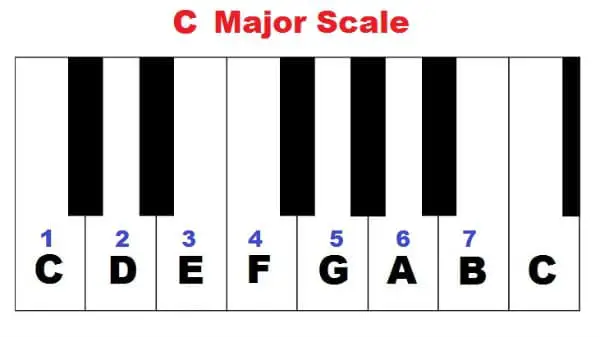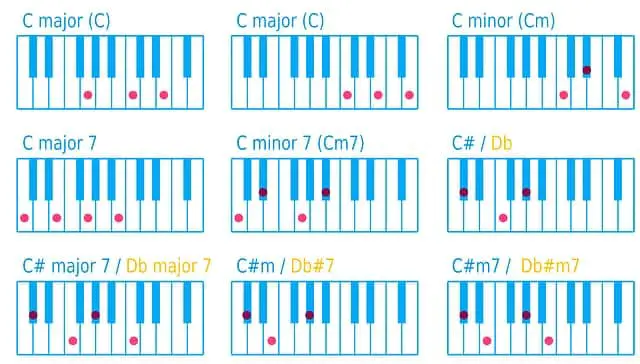- Home
- Piano Chords
- Roman Numerals Chords
Roman Numerals Chords for Piano
This article may contain compensated links. Please read the disclosure for more info.
What are roman numerals chords, and how and why are they used in piano chord progressions?
Let's take a closer look at basic chords and learn how to understand these special chord markings.
Roman Numerals Chords in Music Theory
Roman numerals in music represent the steps of a music scale, either major or minor.
 Roman Numerals in a C major Scale
Roman Numerals in a C major ScaleA triad or a basic chord in root position can be built from each step of a scale. These triads are also called "Diatonic" ("through the key").
 Diatonic Triads in a C Major Scale
Diatonic Triads in a C Major ScaleThe chord on the first step will then be called I, on the second II, third III, on the fourth IV, and the fifth V, and so on. The I, IV, and V chords are the most important in any major or minor scale. They are also the primary chords of the scale.
Why not use "regular" Arabic (1,2,3, etc.) numbers?
Since there are other numbers involved when playing chords (for example, the "number label" for the seventh chord: 7), to avoid confusion, roman numerals are used instead to represent steps on the scale, as well as the chord built on that step.
This also makes it easy to "translate" a piano chord progression to any scale/key you want.
For example:
- Let's use the primary chords: I, IV, and V.
- Find them in any scale/key.
- Then play, for instance, this progression: I, I, IV, I, V, IV. I.
So, you just need to know the scale/key you want to use, then find each chord from the steps in that particular scale. Then follow a chord progression you like that uses roman numerals. You can, in this way, easily change it also to another scale/key.

And why not only use “regular” chord markings, like Gm? (G minor)
Well, those tell you to play in a specific tonality- while the roman numerals chords can be used to play chords in any key. Here is a page where you can learn how it's used in famous chord progressions, written both with chord markings and roman numerals chords.
How to "Count" in Latin :)
- I = 1
- II = 2
- III = 3
- IV = 4 (5-1)
- V = 5
- VI = 6 (5+1)
- VII= 7 (5+2)
- VIII=8 (5+3)
- IX = 9 (10-1)
- X = 10
How Roman Numerals are used for Major and Minor Chords
- Capital numbers: I II III IV V VI VII represent the chords in major.
- Small letter numbers: i ii iii iv v vi vii represent the chords in minor.
If we build chords on every step in the scale (called Diatonic Harmony), all the major scales will get the following chords from each step up:
I - ii - iii - IV - V - vi - vii° and back to I (or VIII)
(The little circle ° means that the chord is diminished.)
Translated to, for example, a C major scale, the chords are:

C – Dm – Em – F – G – Am – B dim, and back to C
Any natural minor scale will get these chords:
i - vii° - III - iv - v - VI - VII - (i)
Translated to for example an A minor scale, the chords are:

Am – B dim. – C – Dm – Em – F – G - Am





